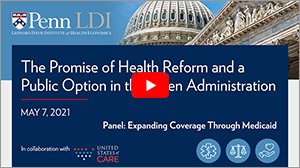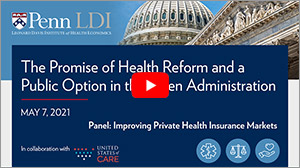Health Care Access & Coverage
News
Health Insurance Public Option Unlikely in Biden Era, Penn LDI Conference Told
Tom Daschle and Ezekiel Emanuel Point to ACA Adjustments, Auto-Enrollments, Medicaid Enhancements, and Regulatory Agency Prerogatives
Potential changes in health policy during the Biden Administration are likely to be defined more by political gauntlets than evidence-based logic, agreed Senator Tom Daschle and Dr. Ezekiel Emanuel in their keynote discussion at a May 7 University of Pennsylvania conference on the future of U.S. health care. Their session within the larger event was called Health Reform in This Political Moment.
“Unfortunately, our country is deeply polarized, and that has created a level of dysfunction that’s very, very troubling not only in Washington, but in states across the country,” said Daschle.

The former Senator and Penn Professor spoke at length about potential health care improvements they believe could be achieved within the existing infrastructure of the Affordable Care Act, Medicaid, and the regulatory prerogatives of federal agencies.
Two other national crises
They also sounded warnings about two national crises that have worsened and become less visible to the public and policymakers during the pandemic: opioid overdose deaths and nationwide mental health system inadequacies.
Daschle and Emanuel were part of the conference titled The Promise of Health Reform and a Public Option in the Biden Administration. Organized by Penn’s Leonard Davis Institute of Health Economics (LDI) in collaboration with United States of Care, the virtual gathering also featured 17 other experts in various areas of health care policy.
Although the concept of creating a “public option,” or government-run health insurance plan to compete with commercial insurance, is championed by many health reform advocates, neither Emanuel nor Daschle expected to see a complicated new project attempted amid the other massive programs the administration is already pursuing.
No long-term structural change

Emanuel, Penn Vice Provost for Global Initiatives and former White House health policy advisor who helped design the Affordable Care Act, pointed out that Biden’s American Rescue Plan, proposed American Jobs Plan, and American Families Plan will cost nearly six trillion dollars. “There’s money in there for boosting subsidies for the ACA exchanges and a few other things,” said Emanuel, “but there’s no long-term health care structural change in that agenda.”
Daschle, a South Dakota Democrat and former Senate Majority Leader who spent 26 years in Congress, pointed out that “democrats obviously want to use governance over the course of the next year to bolster and solidify their hold on the majorities in the House and Senate. So the agenda is going to be dictated in large measure by how they can maneuver in a very narrow corridor of legislative strategy to accomplish as much of that six trillion dollars in investment, in addition to meaningful changes in health care policy, as possible.”
“Dr. Emanuel is right in that there really isn’t a real clear package of health care proposals in the American Families Plan or the American Jobs Plan,” Daschle said. “This will ultimately be something negotiated with Congress. There is a great deal of desire in Congress to address health care in a meaningful way at the same time there are big differences of opinion as to what that policy ought to look like. That legislative strategy is going to determine the election—Republicans are looking at that with an expectation of regaining maybe both the House and the Senate in the November 2020 midterm elections.”
Areas of potential improvement
Daschle asked Emanuel how, within the current political circumstances, policies and programs could be used to reach out more effectively to the uninsured.
“The most basic step,” said Emanuel, “is to think through where the uninsured are and target the biggest group. We have roughly 29-30 million uninsured people. Ten million of them are exchange eligible but aren’t in the exchange. Some of those don’t get subsidies. Most do, but still don’t realize how much those subsidies are worth. Seven million people are Medicaid-eligible but haven’t taken up Medicaid or can’t do the paperwork. Two or three million, depending on your numbers, are in states that haven’t expanded Medicaid. Another 10 million are eligible for employer-sponsored insurance. But, for a variety of reasons, they often don’t think they can afford the premium. As I look at this jigsaw puzzle, there are two clear targets that provide the lowest hanging fruit with the most minimal adjustment. Those are the seven million people who are eligible for Medicaid today in the states were we could get them on the rolls, and the 10 million who are exchange-eligible.”
Auto-enrollment
Emanuel suggested the way to do that was to auto-enroll people both into Medicaid and the exchanges. He said one approach would take anyone eligible for Temporary Assistance for Needy Families (TANF) or Supplemental Nutrition Assistance Program (SNAP) and automatically put them in Medicaid. Hospitals, physician offices, and Medicaid managed care plans could enroll people much more aggressively in the Medicaid program.
Similarly, on the exchange side, Emanuel suggested the IRS could use its information to identify and auto-enroll people into a zero-premium exchange plan. Individuals could opt out of if they chose.
“If we could make these work, you could probably get north of something like 12 to 15 million people additionally enrolled,” said Emanuel.
Boost 400% eligibility threshold?
“I think you’re absolutely right,” Daschle told Emanuel. [Auto-enrollment] could be one of the most powerful and effective tools we have. And it’s an easy thing to do that really isn’t that much of a stretch over what we have been doing these past 10 years.” He went on to ask Emanuel his thoughts on the Biden Administration’s call to raise the eligibility level for exchange subsidies above the 400% of the federal poverty level and fund more navigators for the exchange system.
Emanuel pointed out that insurance rates have risen dramatically during the last 10 years and the 400% subsidy threshold is no longer realistic. “If you’re making $125,000 and are faced with buying a $15,000 health insurance package with no subsidy—that’s a lot of burden,” he said. “Not to mention if you have an employer-level package, which now is clocking in at $21,000 or $22,000. And if they then say, well, for $17,000, you’re going to get this high deductible plan, it becomes hard to justify. Increasing the subsidy level to 500% of the poverty line or more has a lot of logic to it in terms of getting people insured.”
On navigators, Emanuel noted “The Trump Administration understood if you take away advertising, shorten the enrollment period and take away funding for navigators, you will impact exchange enrollment. And they succeeded. Every year Trump was in office the number of people getting ACA coverage declined.”
Crucial importance of navigators
He went on to say that despite its benefits, the ACA exchange system has an inherent problem of complexity and is difficult for many people to wade through. Navigators are crucial to minimizing that problem.
Both speakers agreed Congress looked at the health issue from the two very different perspectives of either increasing enrollment or controlling the affordability of health care services.
“I think affordability trumps enrollment, there,” said Daschle. “When I was born, health care was 4% of GDP. When my children were born, it was 8%. When my grandchildren were born, it was 16% and if I have great-grandchildren, it’s likely to be 32-35%. That’s not sustainable and is a public policy challenge that just can’t be ignored. We’ve suffered from lack of consensus about how to address this. In my view it comes down to price. There are a lot of issues around that but even negotiating drug prices is something you’d think would have bipartisan support—but it doesn’t. In the meantime, I think there will be continuing efforts to find ways to migrate away from fee-for-service and do a better job of addressing affordability, but I’m not optimistic.”
Opioid and mental health crises
“What has really gotten lost this last year is the opioids issue that COVID pushed onto the back burner,” said Daschle. “It’s still a major crisis that can’t be ignored, and we have to resurrect public policy efforts to address this.” Those comments came as new reports detail major spikes in overdose deaths directly related to the pandemic.
On a second, similar issue, Emanuel noted that his lowest grade during medical school was in psychiatry, a subject he was not much interested in. “But over the last decade since the ACA was passed, I’ve gotten religion on mental health and its importance as an integral part of physical health,” he said. “We are way under-invested and need to do more. Look at the workforce. There are only about 25,000 psychiatrists in the country. There are 100,000 or so psychologists and counselors, and maybe 150,000 psychiatric social workers and substance abuse social workers. Overall that’s something like 275,000 mental health workers for a country of 330 million people. We’re severely under-resourced in this area.”
In comments ending the session, Emanuel suggested one more area of action that could have a large impact in improving quality and lowering costs in the U.S. health care system: simplification.
The power of simplicity
“The American health care system is, by far, more complicated than any other health care system in the world,” said Emanuel. “For example, simplifying enrollment into insurance and simplifying the options offered in private insurance would be a big deal. We have a drug pricing system that is so complicated most people can’t understand it—not even experts. So going forward, one thing that can help in enrollment and affordability and in almost every other aspect of health care is a little simplification.”


